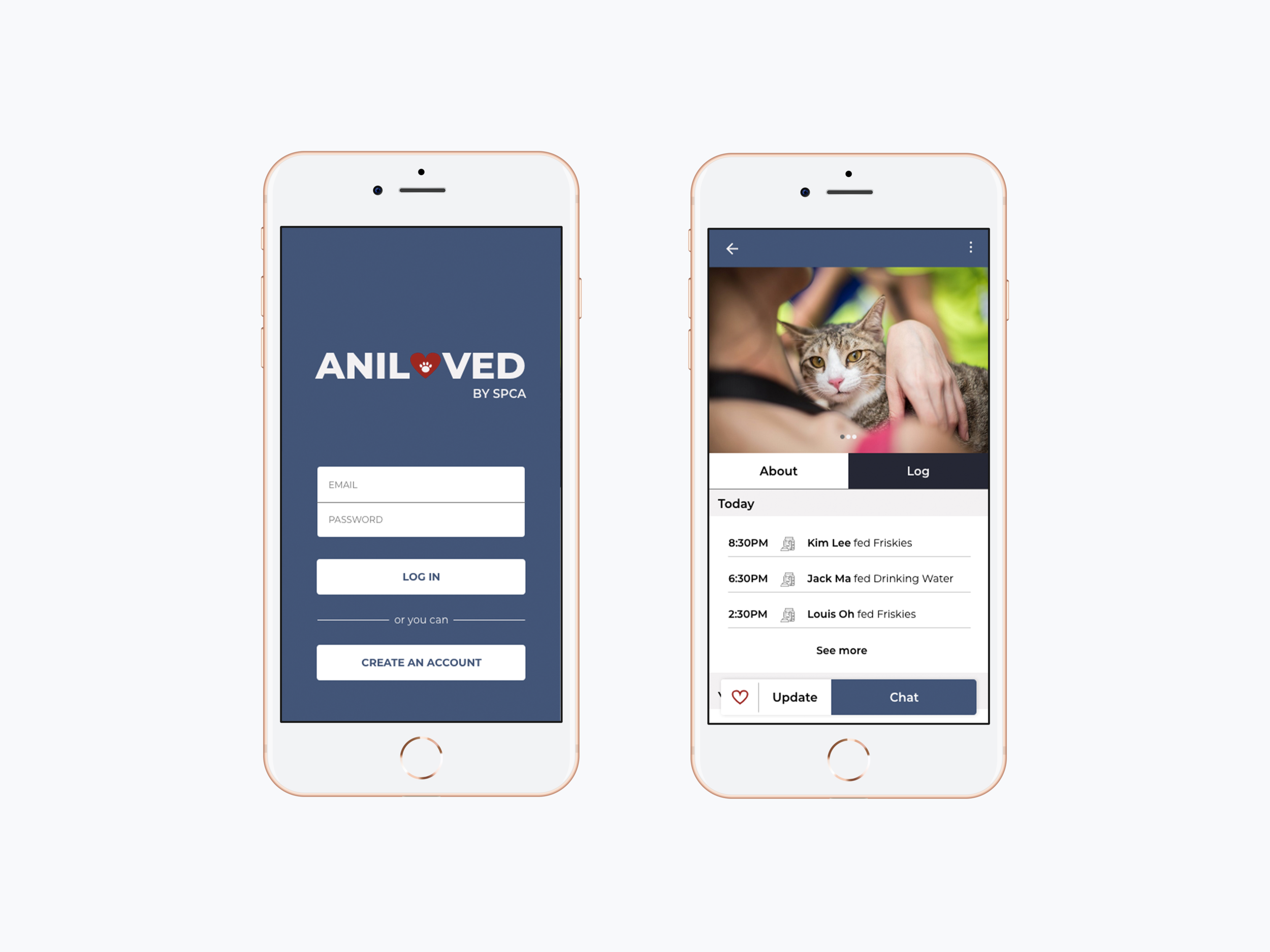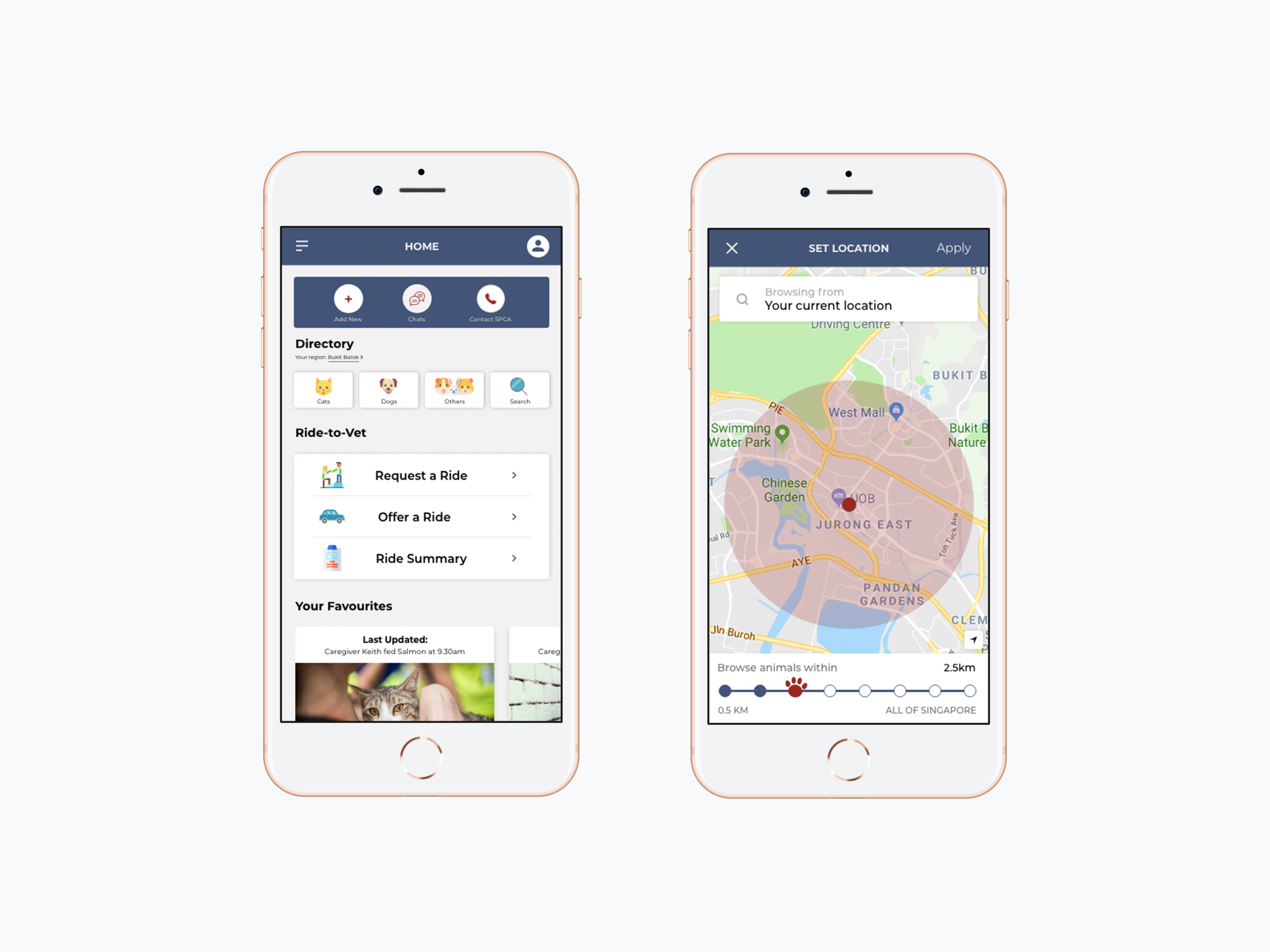
Aniloved.
This is an individual project for the module called User Experience & Interactive Design (UXID).
// UI & UX design + branding
This project is about creating a mobile application for the Society for the Prevention of Cruelty to Animals Singapore (SPCA). It is an app that allows users to not only keep track of community animals but also form a community among community animal lovers. The app will contain features that allow users to request or offer rides to the vet, chat groups for caregivers and also the updating and editing of the animals’ log and information.
Objectives
The mobile app, ANILOVED is an easy-to-use app for all ages which solves the problem that many community caregivers and feeders face – the lack of updates and communication. The app aims to be a platform that connects all community caregivers and feeders of community animals with features such as Ride-to-Vet and the log allows these animal lovers to be kept up to date with the activities of the community animals that they care and love.
User and Market Research
User-centred Design
The research methods used were field studies and interviews. Secondary research was also conducted by searching for relevant articles and UCD-related articles. Based on my user and market research, here are my findings:
This is supported by a study conducted in 2013, by Steven Hoober who performed 1,333 observations of people using their mobile phones. According to the study, users held their mobile phones in 3 different ways, with 49% holding it with one hand, 36% cradled it and 15% using with two hands. It is also stated that one-handed use is highly correlated with users multi-tasking such as using their phones while carrying bags or even holding babies. Also, the latest features in Apple’s iPhones also highlights the usability issue. For example, there is now the double-tap reachability feature which allows users to easily access anything towards the top of the phone and the secret one-handed keyboard which shrinks the keyboard to either side of the screen. However, an app’s UI should not be designed just to accommodate one type of user as it is not right to assume that all users are right-handed or are one-handed users.
It is also found that the top left of the screen is the hardest to reach for users no matter which way they hold their mobile phones. Therefore, it is important for apps running on these devices to keep these users in mind. ANILOVED’s top left corner would be a hamburger menu that stores content that is not as important or frequently accessed. All features and content would be accessible through the home page which will definitely make it easier for one-handed users. Another finding from the field studies and interview is that most users would prefer uploading photos from their photo albums in apps. For example, when they are asked to select a profile picture either by taking a photo or uploading from their photo album, they would choose the latter. Thus, the app will have options that allow users to either upload from the library or to take photos with a camera.
Based on secondary research, it is much easier for users if there is less typing on mobile. This is because users tend to make more errors and will slow down their process of completing their objectives when using the app. Thus, there will be the use of drop-down menus for options when filling up forms in the app. In addition, it is better to make elements such as text, buttons and other controls to be bigger on mobiles due to users’ visions and finger sizes. Smaller targets would make it harder for users to hit as they require higher accuracy and more work/ effort from the users.
The Hub and Spoke model will be used in the app. The model uses a central screen which acts as the launchpad for exploration. To move from one section to another, users must jump back to the hub (Home) first. According to research, this approach eliminates the need for global navigation on each page which is very effective for task-based applications.
Feeding/ Caregivers
Based on the primary research, it is found that caregivers and feeders would prefer feeding dry treats/food to the community animals. This is because it results in less mess and is easy to clean up.
Feeders would also bring along a plastic container or bowl and top it up with drinking water for the animals. The community animals would trail towards the feeders as they recognise that these are the people feeding them. Some of the problems that feeders and caregivers found were that they have no idea as to whether the community animals were fed by others. This caused the caregivers and feeders to feel bad when they did not purchase food for the animals especially when they were not fed.
Communication is also said to be very important among caregivers and feeders. As shared by dog rescuer, Ms Sharon, there is always a sense of urgency when it comes to animal rescue. In addition, communication between feeders and caregivers allows one another to be updated with information. For example, feeders would be updated with information as to whether the cats were fed so that they do not have to make a wasted trip to the pet shop for pet treats. Ms Sharon also talked about the need for names of people who are able to provide help such as monetary sponsorships or simply driving the animals to the vet. This is backed up by the secondary research conducted which found that caregivers would bring the animals to the vet when they are injured or unwell and would pay for their medical fees. This inspired the feature of “Ride-to-Vet” as it allows the community of animal lovers to help one another by simply driving the community animals to the vet.
Information Architecture // Sitemap



